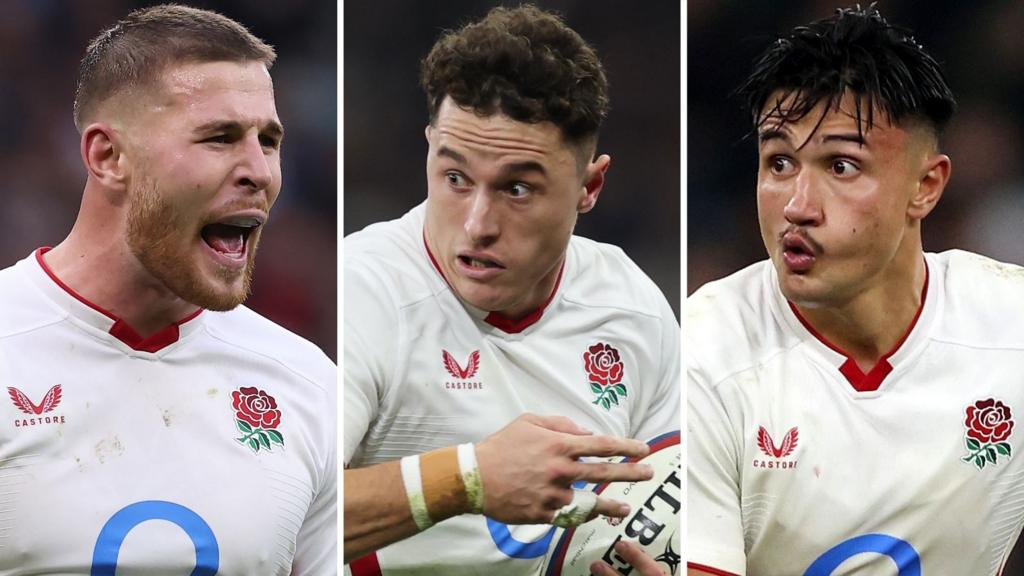Freddie Steward, Henry Arundell, and Marcus Smith are among England’s considerations for the back three.
Quilter Nations Series: England v New Zealand
Venue: Allianz Stadium, Twickenham Date: Saturday, 15 November Kick-off: 15:10 GMT
Coverage: Live on BBC Radio 5 Live and the BBC Sport website and app
Assembling a modern back three demands a delicate balance.
Competence under the high ball is paramount, given the unimpeded routes chasers now have to aerial contests.
Exceptional speed offers an immediate advantage, potentially converting rare openings into points.
The inclusion of a versatile playmaker, capable of supporting or substituting at fly-half, is increasingly favored to diversify tactical options.
Scotland’s Blair Kinghorn, New Zealand’s Damian McKenzie, France’s Thomas Ramos, and South Africa’s Damien Willemse exemplify Test full-backs with fly-half experience.
For England, coach Steve Borthwick benefits from considerable depth in all areas.
Rugby Union Weekly: ‘Boks Office’ drama in Paris and England’s quest for 10′
A combination of Immanuel Feyi-Waboso, Henry Arundell, and Cadan Murley (11-15-14) would offer blistering pace.
Conversely, a trio of Tommy Freeman, Freddie Steward, and Tom Roebuck would excel in aerial contests, while Marcus Smith and Elliot Daly – returning after recovering from a broken arm sustained on British and Irish Lions duty in July – provide playmaking expertise in the backfield.
Facing New Zealand on Saturday, Borthwick must navigate injuries and experience, aligning his tactical strategy with potential All Blacks’ plays to secure victory.
Daly is back in contention after suffering a broken arm on the Lions tour of Australia in the summer
According to former England wing Ugo Monye, given Freeman’s injury concerns from the weekend’s win over Fiji and Roebuck’s recovery from an ankle issue, Borthwick may lean towards a back three of Feyi-Waboso and Arundell, flanking Steward at full-back.
“If Elliot Daly was fully fit and sharp, he would be my pick at 15,” Monye stated on Rugby Union Weekly.
“However, he’s been out for an extended period, and his fitness is uncertain.
“With Manny [Feyi-Waboso] on the right wing, and Daly unavailable, Steward should feature at full-back with Arundell on the left wing.
“It’s a potent combination, but a few injuries and disruptions have forced a back three that deviates from the original plan.
“While still a strong back three, it may not perfectly align with England’s desired playing style, given Arundell’s preference for ball-in-hand play over aerial contests. However, Steward and Feyi-Waboso are exceptional in that area.”
Former England scrum-half Danny Care notes that the demanding autumn international schedule – with four consecutive matches – is testing England’s depth in the backfield.
“We’ve been discussing the depth and strength of this England squad for weeks; this weekend will be a true test,” he remarked on Rugby Union Weekly.
Monye concurred, suggesting England might need to include three backs on the eight-man bench – rather than the two in previous wins against Australia and Fiji – to provide support for an unfamiliar combination.
Matt Dawson, a 2003 World Cup winner with England, argues that Marcus Smith shouldn’t be considered for the back three, preferring his creative talents as a game-changing fly-half replacement.
“I don’t see Marcus as a full-back at the highest level,” he wrote in his BBC Sport column. “I question the value of playing him there.
“I want the ball in his hands as much as possible, but that should be in the front line, particularly in the final 20 minutes.”
Listen: Sport’s Strangest Crimes – Bloodgate
Listen to the latest Rugby Union Weekly podcast
Comments can not be loaded
To load Comments you need to enable JavaScript in your browser

